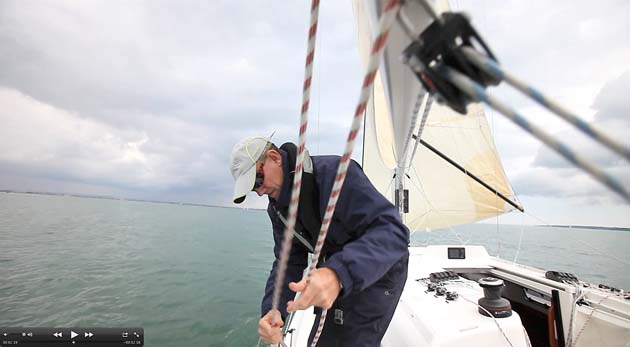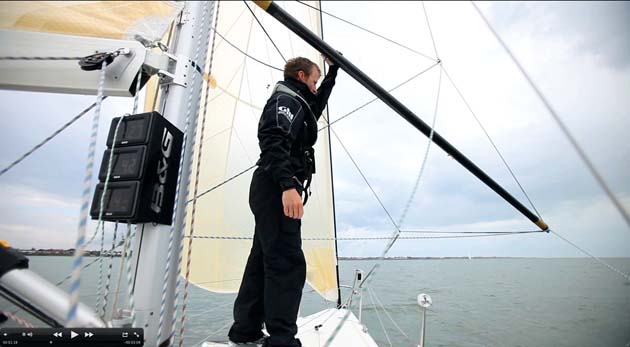In part 8 of our series on advanced sailing techniques, Pip Hare describes how best to set up your yacht for downwind sailing under white sails only
![]()
Downwind sailing doesn’t have to be about screaming off waves under full spinnaker, and those of us who have crossed oceans in boats that are also our homes will know there is a balance to be had between sailing fast, reducing the risk of wear and chafe and having time to relax and enjoy the sunset while still making the miles.
In this feature and video I suggest a few of the downwind techniques I have used when the spinnaker was not an option.
See our video of SAIL FASTER SAIL SAFER Part 8
Preventers
When sailing downwind for extended periods of time in rolly conditions and light breeze a preventer can be an essential part of the boat’s set-up.
Remember, a preventer is to stop the boom from swinging across the boat, it does not stop the boat itself from gybing; and it is possible on pilot failure or with an extreme windshift for the whole mainsail to fill from behind while pinned by the preventer.
To cope with this scenario or dipping the boom end it is essential that you are able to handle the preventer from the cockpit.
Attach a strong line – a spinnaker guy will do – to the end of the boom, either by placing a loop around the boom end outboard of the clew of the sail, or passing through an attachment already there and designed for this purpose.
If using a shackle to attach the rope, make sure it has a tripping line through the trigger device, which can be taped loosely along the preventer and fired from inboard while the boom is out. If you are tying it, then make the loop long so the knot can be reached in the same manner.
The preventer will have best purchase to hold the boom if led from the outboard end, well forward to a turning block on the toerail or simply under a cleat on the foredeck. From here lead the rope back, under the jib sheets to a winch in the cockpit, where it can be tightened, paid out under control or released quickly.
Setting a preventer:

Preventer led forward:

Attach preventer with long bowline:

Poling out
The trick here is to set up the pole entirely independently of the sail, using its own set of guys, enabling completely free movement of the sail with its own genoa sheets; meaning you manoeuvre the sail without the pole swinging around in the way.
With the headsail rolled or on the leeward side, attach a guy to the end of the pole itself – normally this can be done on the same fitting as the downhaul – take a long sheet and attach this to the clew of the headsail, pass it through the jaws of the pole and continue outside the boat to a turning block aft.
Once the sheet and pole guy are in place, raise the pole on the windward side and secure it with the pole guy and pole uphaul working against the pole downhaul to keep it steady. Aim to have the outboard end of the pole at the same height as the clew of the genoa and the inboard ended higher up the mast. You will not need to use the full length of the pole so don’t put it horizontal.
With the pole secured, use the new sheet to bring the genoa over to the windward side, releasing the normal sheets.
If you need to roll the sail quickly or gybe it, simply release the long sheet and pull on the normal sheets; the sail will move away while the pole stays in place.
Set pole independently of jib:

Roll sail out to pole end:

Twin headsails
A tried and tested method for tradewind sailors, using twin headsails allows you to maximise your downwind speed without using the mainsail, giving a stress-free ride with no worries about gybing or long-term chafe from the spreaders.
Have a clear strategy for hoisting and dropping the headsails so if you get hit by a squall or a change in wind direction you can act quickly and won’t have to deal with two flapping monsters at the front of the boat.
 If you have a twin-groove furler, then it may be possible to feed the second headsail up the spare groove and attach it to the same points as the tack and head of the other, using strops at either end if the luff length is shorter. Set this in port to make sure the roller will still be able to turn with both sails on and will not be damaged.
If you have a twin-groove furler, then it may be possible to feed the second headsail up the spare groove and attach it to the same points as the tack and head of the other, using strops at either end if the luff length is shorter. Set this in port to make sure the roller will still be able to turn with both sails on and will not be damaged.
Hanked-on headsails can both be attached to the forestay, but remember if you need to drop them, both halyards need to be released together.
If only able to attach one sail to the forestay then the other will need to be free- flying like a gennaker; this allows you to fly the sail with an eased halyard, giving it more a fuller shape, but making it less stable.
It is possible to fly both headsails loose- luffed in this manner; just remember if you need to get them down in a hurry, this can be hard work.
Aim to stabilise the bigger headsail on the windward side with the pole, and the smaller one can be stabilised in a similar way using the boom.
Position the boom using a preventer so the end is outboard, then hang a block from the end of the boom and, as with poling out the headsail, pass a long separate sheet from the clew of the genoa, through the block and then to the back of the boat.
See more about downwind sailing in our survey of ARC skippers HERE
Top tips
- Use compass mode on your autopilot to steer the boat. To set the pilot up well you will need to play with the response or gain. Do this by hand steering and monitoring how often you have to move the helm to stay on course. Aim to set the response level to make adjustments at the same rate.
- Sailing for extended periods downwind under preventer can cause chafe on the mainsail from the spreaders. Try putting extra wear patches on for long passages.
- Watch for chafe of the genoa sheets through the pole end. A protective jacket on the first foot of the rope provides a good solution for this.
- Practise taking down the pole and releasing the preventer with delivery crew. It’s easy to set up, but to take it down in a hurry in the dark can be a different story.
 Single-handed ocean sailor Pip Hare has clocked up thousands of miles racing and cruising. Among her achievements are five solo transatlantics, including the OSTAR and two Mini Transat races. She also works full-time for the RNLI on sea safety and is Consulting Editor on Yachting World. See also her series on short-handed sailing
Single-handed ocean sailor Pip Hare has clocked up thousands of miles racing and cruising. Among her achievements are five solo transatlantics, including the OSTAR and two Mini Transat races. She also works full-time for the RNLI on sea safety and is Consulting Editor on Yachting World. See also her series on short-handed sailing
SAIL FASTER SAIL SAFER Part 9: Pip Hare looks at sailing downwind with a spinnaker
12 part series in association with Pantaenius




